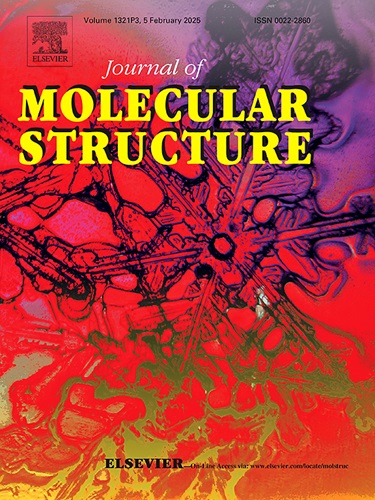Synthesis, molecular docking simulation, and antifungal activities of novel strobilurin derivatives containing covalent reactive warheads
IF 4
2区 化学
Q2 CHEMISTRY, PHYSICAL
引用次数: 0
Abstract
The prolonged overuse of strobilurin fungicides has exacerbated resistance issues, diminishing control efficacy. Despite extensive modification of strobilurin core scaffolds, fungicide resistances persist unresolved. To discover strobilurin fungicides with novel modes of action, we performed covalent drug design targeting the Cys39 residue of cytochrome b in Colletotrichum gloeosporioides. Specifically, covalent reactive warheads (acrylamide and chloroacetamide) were strategically incorporated into methoxyimino acetate and methoxyacrylate scaffolds through rational molecular design. This approach yielded two series of 36 novel strobilurin derivatives, with some exhibiting significantly higher antifungal activity against C. gloeosporioides. Compounds 6e, 6h, 6i, 6j, 6s, and 14c exhibited EC50 values (42.0, 41.0, 18.5, 25.9, 43.8, and 19.8 μg/mL, respectively) exceeding that of kresoxim-methyl (EC50 > 100 μg/mL), with 6i and 14c showing particularly potent activity. Morphological analysis, electrical conductivity assays and intracellular content leakage measurements were conducted to confirm compound 6i disrupted cellular membrane integrity. Further non-covalent and covalent molecular docking results indicated compounds 6i and 14c bound effectively to cyt b and positioned their functional groups in a favorable geometry for covalent reaction with Cys39. This study offers a potential solution for structural modification of resistant pesticides.

含有共价反应弹头的新型strobilurin衍生物的合成、分子对接模拟和抗真菌活性
strobilurin杀菌剂的长期过度使用加剧了耐药性问题,降低了控制效果。尽管对strobilurin核心支架进行了广泛的修饰,但杀菌剂耐药性仍未得到解决。为了发现具有新作用模式的双孢脲类杀菌剂,我们以炭疽菌细胞色素b的Cys39残基为靶点进行了共价药物设计。具体而言,通过合理的分子设计,将共价反应性战斗部(丙烯酰胺和氯乙酰胺)战略性地纳入醋酸甲氧基亚胺和甲氧基丙烯酸酯支架中。该方法得到了两个系列的36个新的strobilurin衍生物,其中一些衍生物对gloeosporioides具有明显更高的抗真菌活性。化合物6e、6h、6i、6j、6s和14c的EC50值(分别为42.0、41.0、18.5、25.9、43.8和19.8 μg/mL)高于甲基克雷索辛(EC50 >;100 μg/mL),其中6i和14c活性特别强。形态学分析、电导率测定和细胞内含量泄漏测量证实化合物6i破坏了细胞膜的完整性。进一步的非共价和共价分子对接结果表明,化合物6i和14c与cyt b有效结合,并将其官能团定位在有利于与Cys39共价反应的几何位置。该研究为抗性农药的结构修饰提供了一种潜在的解决方案。
本文章由计算机程序翻译,如有差异,请以英文原文为准。
求助全文
约1分钟内获得全文
求助全文
来源期刊

Journal of Molecular Structure
化学-物理化学
CiteScore
7.10
自引率
15.80%
发文量
2384
审稿时长
45 days
期刊介绍:
The Journal of Molecular Structure is dedicated to the publication of full-length articles and review papers, providing important new structural information on all types of chemical species including:
• Stable and unstable molecules in all types of environments (vapour, molecular beam, liquid, solution, liquid crystal, solid state, matrix-isolated, surface-absorbed etc.)
• Chemical intermediates
• Molecules in excited states
• Biological molecules
• Polymers.
The methods used may include any combination of spectroscopic and non-spectroscopic techniques, for example:
• Infrared spectroscopy (mid, far, near)
• Raman spectroscopy and non-linear Raman methods (CARS, etc.)
• Electronic absorption spectroscopy
• Optical rotatory dispersion and circular dichroism
• Fluorescence and phosphorescence techniques
• Electron spectroscopies (PES, XPS), EXAFS, etc.
• Microwave spectroscopy
• Electron diffraction
• NMR and ESR spectroscopies
• Mössbauer spectroscopy
• X-ray crystallography
• Charge Density Analyses
• Computational Studies (supplementing experimental methods)
We encourage publications combining theoretical and experimental approaches. The structural insights gained by the studies should be correlated with the properties, activity and/ or reactivity of the molecule under investigation and the relevance of this molecule and its implications should be discussed.
 求助内容:
求助内容: 应助结果提醒方式:
应助结果提醒方式:


